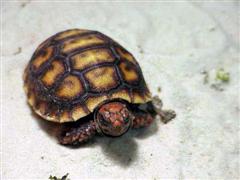Red Foot Tortoise
Redfoot Tortoise, Red-foot Tortoise, Red Leg Tortoise, Savanna Tortoise Scientific Name: Chelonoidis carbonaria
Sat, 26th April, 2025 - 4:51 am GMT
Sponsor Ads:

Alternative Name
Redfoot Tortoise, Red-foot Tortoise, Red Leg Tortoise, Savanna Tortoise Scientific Name: Chelonoidis carbonariaBasic Info
The largest known Redfoot Tortoise was 17.75 inches long. Most others, however, will reach a maximum of 10 to 12 inches. Their shell is more oval than round, and when viewed from above, many Redfoot Tortoises will have a slight hourglass figure to their shell. The color of the shell is dark brown to black, with yellow marks in the center of the laminae (lower shell). Male Redfoots tend to be a few inches larger than the females, have larger tails, and have a concave plastron (lower shell).
Health
A typical habitat for a Redfoot Tortoise should be large enough for it to walk around, and contain several elements - a pool, a basking spot, and a shady spot. This would be atleast 10 to 20 square feet. If weather permits, they should be housed outdoors. When housed indoors the tortoises should be eposed to full spectrum UV lighting for about 13 hours a day. The Redfoot Tortoise especially needs water to soak and defecate in. If these tortoises are to be kept successfully, they will need to have a temperature gradient so they can move to cooler areas when needed, and likewise, also move to warmer basking areas. During the day, they sould have acces to areas about 90 - 95 degrees Fahrenheit and cooler areas in the low to mid 80s. At night the temperature should be lowered to about 68 to 75 degrees Fahrenheit. Breeding Redfoot Tortoises have peculiar mating rituals. If two Redfoot Tortoises are to mate, they first stand at each other's side. The instigating male will begin shaking its head to the side. If the other Tortoise is a male, it will shake its head in response, and the two will usually get into a mini-brawl. If it is a female, the Tortoise will not respond. The male will sniff the female's tail to make sure it's a female, and if confirmed, mating will commence. During a mating session, the male will make a clucking sound, which is similar to the clucking of a hen. Eggs incubate for about 120 days. Incubation temperatures should remain at 86 degrees Fahrenheit.Habitat
They are found in the moderate savannah, grassland, and deep forest climates.Behavior
The Redfoot Tortoise, also known as the Redleg or Savanna Tortoise, makes a great pet. It is intelligent, hardy, and usually does well in captivity. These traits, combined with its beautiful colors, have made the Redfoot a popular tortoise pet. Redfoot Tortoises get their name from the red, orange, and yellow spots on their head and legs. These colors make the Redfoot Tortoise a beautiful and exotic animal. The Redfoot is a tortoise who interacts well with people, and is not overly aggressive to other tortoises.They react well with kids and adults and usually reach maturity in 15 years. The Redfoot Tortoise prefers temperatures between 75 to 90 degrees Fahrenheit, with light to moderate humidity.Origin
South AmericaHistory
The Redfoot Tortoise is found in many areas. The Redfoot Tortoise inhabits several nations in South America including Venezuela, Brazil, Ecuador, and Paraguay. There is much variation in their size and color, but there are no sub-species of the Redfoot Tortoise. However, there have been recent sales of "dwarf" Redfoot Tortoise. These are smaller then regular Redfoot Tortoise, reaching a mature size of 6 to 8 inches.Common Foods
The Redfoot Tortoise is mostly herbivorous, but is known to eat carrion and insects sometimes. In captivity, they should be fed a mostly herbivorous diet consisiting mostly of grasses, dark leafy green vegetables, but also containing soft vegetables suchSponsor Ads:
"With his forces intact he will dispute the mastery of the Empire, and thus, without losing a man, his triumph will be complete. This is the method of attacking by stratagem." -- Sun Tzu, The Art of War
Red Foot Tortoise
Coded by: BGID® | ALL RIGHTS RESERVED Copyright © 2000-2025
Disclaimer | Privacy | Report Errors / Contact | Credits


 Why haven't we as a collective earth met with aliens yet?
Why haven't we as a collective earth met with aliens yet?  The Best Text Adventure You Will Ever Play! The official site:
The Best Text Adventure You Will Ever Play! The official site:  Homosexual behavior stems from the mind or genetics?
Homosexual behavior stems from the mind or genetics?  World EcoSystem - Biodiversity Changes - Who is on board and who isn
World EcoSystem - Biodiversity Changes - Who is on board and who isn  Mouthwash - Mouthrinse - Mouth Sores - Healing Infections - Gingivitis
Mouthwash - Mouthrinse - Mouth Sores - Healing Infections - Gingivitis  Treatment for Depression
Treatment for Depression  Ultra radical and violent Islamist group that even rivals Al Qaeda
Ultra radical and violent Islamist group that even rivals Al Qaeda  An idea to have teachers who want to carry guns to school undergo some level of police training will be left up to local school districts and police departments.
An idea to have teachers who want to carry guns to school undergo some level of police training will be left up to local school districts and police departments.